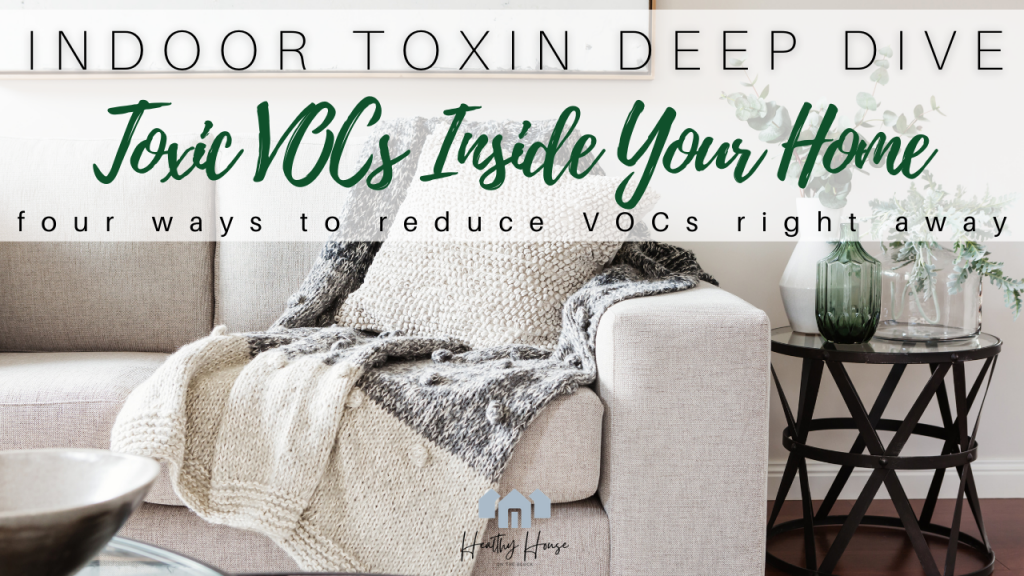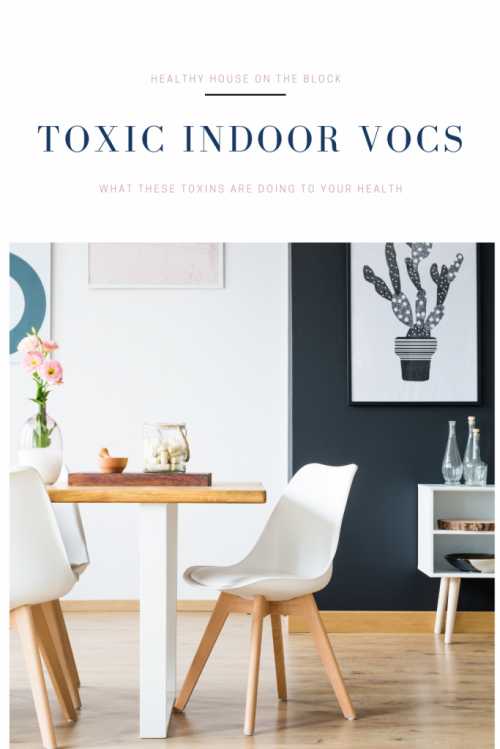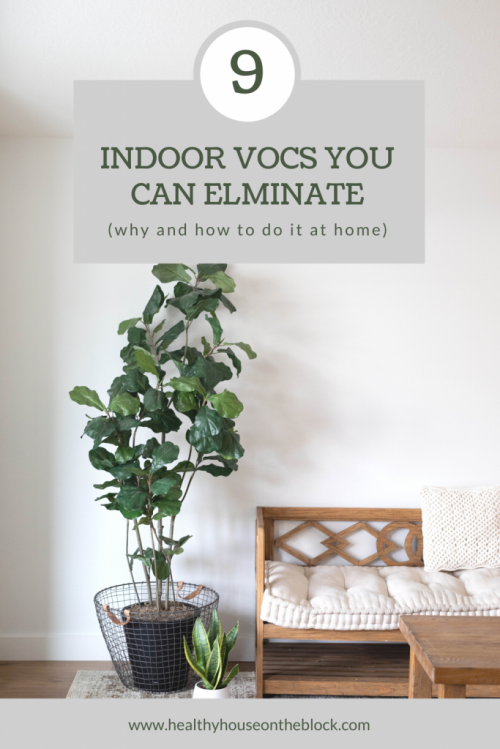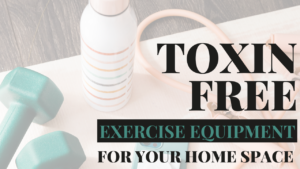
One of those popular terms when it comes to a healthy home is “VOC free”. But what are VOCs? My stance on just about any toxin is you have to know what it is, how it affects your health and where it comes from in order to properly change your lifestyle, habits and products to get rid of it.
VOCs are volatile organic compounds that have become highly regulated over the past few years in terms of products that we bring into our home. Yet so may products that claim to be “green” and “natural” still contain these toxins.
Because of this greenwashing tactic, the time has come for us as homeowners and consumers to be armed with knowledge and facts in order to change our homes for the better. It’s important to know what chemicals are in the VOC category and how to avoid them in our everyday products and our home materials.
VOCs are so prevalent and we are surrounded by them so regularly that our bodies are rarely getting a good break from them. This is why I think it’s so important to pay attention to. Any place we can reduce VOCs in our home can give our bodies that small break from toxins it needs to function at a higher level.
WHAT ARE VOCS?
Certain products in your home, both solids and liquids can emit a gas called a volatile organic compound. VOCs are present indoors and outdoors, but indoors they can become highly concentrated, leading to concern of health impacts. VOCs are carbon containing substances that vaporize at room temperature.
VOCs are released into the air by a material or product. The VOC can sometimes have an odor that is emitted with it, but not always. The compounds that are released are unstable, which means certain circumstances can determine how much gas they release into the air. Often these circumstances are temperature and humidity, which we can control in our homes. There can also be a wide range of HOW a VOC is produced in the air. Some materials will off-gas for a short amount of time, and some will off-gas at low levels continuously.
There are also different classifications of VOC pollutants: Very volatile (VVOC), volatile organic compounds (VOC) and Semi volatile (SVOC). The classification is based on the volatility of the c based on their boiling points, which determines how much they off gas under normal air pressure.
The problem with VOCs and understanding what are VOCs in general is that the level indoors is often 2 to 5 times higher than outdoors. (SOURCE)

When a VOC is released, it evaporates into the air under normal indoor air pressure (atmospheric pressure). Outdoors it may dissipate and become diluted with fresh air. Indoors, however, it can become very concentrated. Indoor air doesn’t get exchanged with fresh outdoor air on a regular basis unless our homes are properly mechanically ventilated, which many are not.
In answering the question “What are VOCs”, so many notable facts come up to help us understand them better as a consumer and homeowner. One of those important facts to know about VOCs is that there is no way to measure ALL VOCs in your space with one method. Many VOCs are measured with different methods because they are all different compounds. In order to test for VOCs in your own space you’d likely need several devices or a professional.

WHERE DO VOCS COME FROM?
While there are HUNDREDS of VOCs, both in nature and in our homes, there are some VOCs that are more harmful to us than others because they exist at room temperature, meaning we are almost constantly being exposed. These are often the VOCs that we talk about in our homes and do our best to avoid.
Paints & Stains: Paint, stains and varnishes commonly all contain VOCs. They typically off-gas with an odor that is emitted. VOCs are used in these products to improve the quality of the product as well as the performance. Generally these products off-gas the most when being used, but can emit a low level of VOCs constantly. Most products list the level of VOCs that are emitted from the product on the product label.
Carpet & Flooring: Formaldehyde, benzene and ethylene glycol are the most common VOCs that are emitted from flooring and carpet. In carpet the main problem is the backing and in flooring the culprit is often adhesives used in either installation or manufacturing. In general most flooring products off gas the most right away, but low levels can continue to off gas over time.
Composite Wood: The glue in composite wood (plywood, particle board, medium density fiberboard or MDF) usually contains a formaldehyde product to ensure it’s durability. Formaldehyde is one of the more known VOCs and can off gas for years. Composite wood is also used in many applications around the home from the building materials themselves to our furniture. If you’re looking for healthy alternatives to composite wood, this article will help you find VOC free products.

Cosmetics & Perfume: Synthetic fragrance, nail polish and nail polish removers, hair sprays and styling products: they all contain VOCs. These types of products generally emit VOCs during use and can sometimes off gas while being stored as well. Usually the VOCs present in cosmetics are toluene, ethanol, xylene and acetone. (SOURCE) THey help to preserve these products and also help products to keep from separating. In some products these VOCs help them adhere to our bodies (think nail polish and hairspray).
Adhesives & Glues: Anything from craft glue to industrial adhesives can contain VOCs. The most common VOC in adhesives and glues is formaldehyde and nitrogen oxides, which generally off-gas the most during the curing process as the product is drying. These VOCs help make the products easily workable and more fluid. In the building process of homes, many types of strong adhesives are used in a variety of applications.
Air Fresheners & Synthetic Fragrance: This list of synthetic fragrances you can replace in your home is extremely eye opening in terms of just how many places fragrances are hiding in our everyday products. A study done on just 25 scented products showed that the average number of VOCs emitted from just one product was about 17. The most common VOCs in fragrance products are formaldehyde, ethanol, terpene and acetone. (SOURCE). With these VOCs, you’re likely being exposed if you smell the fragrance.
Upholstery & Foam: Formaldehyde is again the most common VOC in furniture and foam. (benzene, methyl chloride and toluene are also commonly used in foam) The protective coating that is added to upholstery (to make it stain and moisture resistant). These products are one of the most concerning because it’s been found that VOCs in furniture foam off gas much more when the material is warm and has a more humid climate around it. Our bodies produce this conducive environment naturally as we come in contact with the furniture and foam in mattresses and cushions (SOURCE).
Cleaning Products: Cleaning products is a pretty broad term and so the list of types of VOCs is endless in these solutions. These products are similar to beauty products in that they mostly off-gas while they’re being used, but can also emit VOCs when being stored. Formaldehyde is often used as a preservative in these products as well as several other VOCs to improve the product’s function as well as cover up odors.

VOC EXAMPLES
- Benzene: A highly flammable VOC and used in Can cause anemia, and issues with bone marrow as well as a human carcinogen (SOURCE).
- Ethanol: The most common VOC in cosmetics and beauty products as it helps to clean skin and acts as a preservative. It also helps products adhere to the human body. Can cause respiratory issues (SOURCE)
- Formaldehyde: Used in a variety of applications from personal products to building materials. It acts as a preservative and as a bonding agent. It has been linked to long term health issues with the sinuses and respiratory system as well as being a a human carcinogen (SOURCE)
- Methylene Chloride: This VOC is most commonly found in varnishes and coatings. It can cause chronic dermatitis as well as permanent nerve and liver damage. It is a possible carcinogen to humans, but more research needs to be done. (SOURCE)
- Acetone (also known as propane): Most commonly used in nail polish remover, it is used to reduce the viscosity of solutions and helps “blend” a variety of solutions. Acetone can cause issues with the blood, as well as damage to the kidneys, liver and nerves. (SOURCE)
- Carbon Disulfide: Linked to reproductive effects (like decreased sperm count and disturbances in the menstrual cycle) as well as neurological effects resulting in behavioral changes. (SOURCE)
- Dichlorobenzene: Usually used as a repellent for insects, rodents and a deodorizer for bathrooms and nurseries. It has been linked to negative affects of the lungs and blood cells as well as cause damage to the liver and kidneys. (SOURCE)
- Toluene: Helps to dissolve other thick substances. A human carcinogen (SOURCE) as well as chronic effects on the central nervous system like tremors, involuntary eye movements and impaired speech, hearing or vision. (SOURCE)
- Xylene: Used in many glues, cleaning products, paints and sealants.. Xylene can be linked to chronic dermatitis, depression, headaches, insomnia, irritability and damage to the kidneys and liver. (SOURCE) It also a human carcinogen (SOURCE)

HOW TO REDUCE VOCS
Buy VOC Free: First and foremost, opt for VOC free or Low VOC products. Many paint, varnish and sealer products are labeled with the VOC emissions right on the can. You can also look at GreenGuard Certified products when you’re looking at building materials, paints and stains and adhesives.
Another way to be sure about what you’re purchasing is to shop from credible sources that sell plant based products or certified products. Below are a few of my favorites for beauty, home materials, and cleaning products:
And for bigger purchases, make sure you’re doing your research beforehand. I have tons of specific and individual guides that help you pick out the healthy products and materials you want in your home:
Ventilation: Escaping all VOCs is nearly impossible, and because of the nature of our energy efficient houses, there will always be some level of VOCs in our home. Ventilating your home by opening windows and doors on a regular basis as well as running vented fans or air to air exchangers if you have them is the BEST way to get fresh air in and push toxic air out. Creating more and more air exchanges in your home is the best way to dilute toxin concentrated air at home.
Climate Control: We know that air that is warm and high in humidity levels creates and environment where VOCs will off gas at a higher and more frequent rate. Keeping indoor relative humidity between 35% – 45% is ideal for not only VOC emission but mold and dustmite control as well.
Air Purification: Finally, some VOCs, like formaldehyde can be reduced with an indoor air purifier. I love using MedifyAir in my own home as they use a medical grade HEPA filter that filters out 99.9% of all particles down to .1 microns.
Understanding what are VOCs and their health effects is the first step to reducing this toxin in your home. By reducing VOCs at home you can begin to create a healthier indoor environment that supports your health and wellness at home.

Share this:
- Click to share on Facebook (Opens in new window) Facebook
- Click to share on LinkedIn (Opens in new window) LinkedIn
- Click to share on Reddit (Opens in new window) Reddit
- Click to share on Pinterest (Opens in new window) Pinterest
- Click to print (Opens in new window) Print
- Click to share on X (Opens in new window) X




Hi Amanda, I just purchased a couch loaded with formaldehyde I’m assuming. I have a migraine and just feel weak. All sales final no return kind of store smh..I had the same issue last year from a different store with a king size wood bedframe. I was able to return that. But I’m stuck with this one..its heavy and no way to take outside it’s a sectional.
I heard plants were helpful and maybe baking soda. Any advice? sorry for the long note
Pingback: New Home Toxins: How to Reduce Off Gassing in New Construction
Pingback: Non-Toxic Wallpaper » Healthy House on the Block
Pingback: Home Toxins based on the Age of Your Home (new or old home)
Pingback: Identify Toxic Materials: Avoiding Sick Building Syndrome
Pingback: Preventing Allergies and Asthma Symptoms in Kids